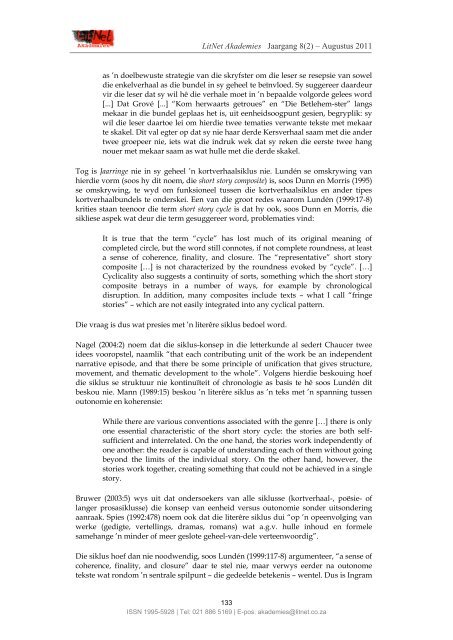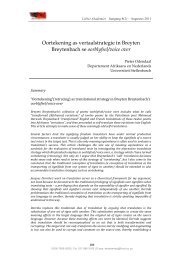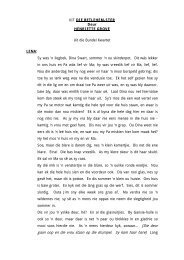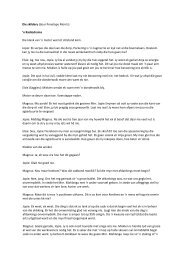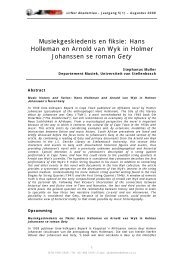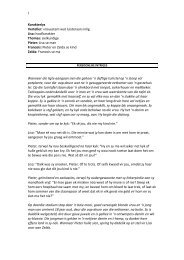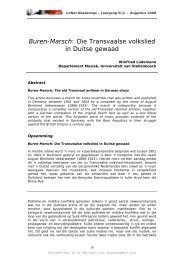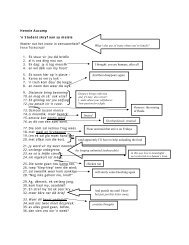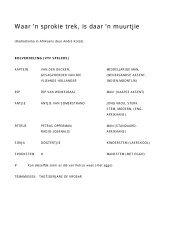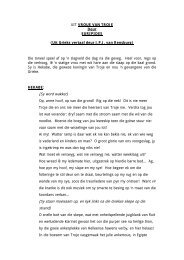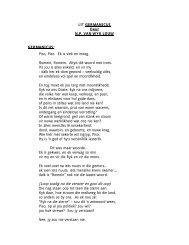Jaargang 8, nommer 2 – Augustus 2011 - LitNet
Jaargang 8, nommer 2 – Augustus 2011 - LitNet
Jaargang 8, nommer 2 – Augustus 2011 - LitNet
Create successful ePaper yourself
Turn your PDF publications into a flip-book with our unique Google optimized e-Paper software.
<strong>LitNet</strong> Akademies <strong>Jaargang</strong> 8(2) <strong>–</strong> <strong>Augustus</strong> <strong>2011</strong><br />
as ‘n doelbewuste strategie van die skryfster om die leser se resepsie van sowel<br />
die enkelverhaal as die bundel in sy geheel te beïnvloed. Sy suggereer daardeur<br />
vir die leser dat sy wil hê die verhale moet in ‘n bepaalde volgorde gelees word<br />
[...] Dat Grové [...] ―Kom herwaarts getroues‖ en ―Die Betlehem-ster‖ langs<br />
mekaar in die bundel geplaas het is, uit eenheidsoogpunt gesien, begryplik: sy<br />
wil die leser daartoe lei om hierdie twee tematies verwante tekste met mekaar<br />
te skakel. Dit val egter op dat sy nie haar derde Kersverhaal saam met die ander<br />
twee groepeer nie, iets wat die indruk wek dat sy reken die eerste twee hang<br />
nouer met mekaar saam as wat hulle met die derde skakel.<br />
Tog is Jaarringe nie in sy geheel ‘n kortverhaalsiklus nie. Lundén se omskrywing van<br />
hierdie vorm (soos hy dit noem, die short story composite) is, soos Dunn en Morris (1995)<br />
se omskrywing, te wyd om funksioneel tussen die kortverhaalsiklus en ander tipes<br />
kortverhaalbundels te onderskei. Een van die groot redes waarom Lundén (1999:17-8)<br />
krities staan teenoor die term short story cycle is dat hy ook, soos Dunn en Morris, die<br />
sikliese aspek wat deur die term gesuggereer word, problematies vind:<br />
It is true that the term ―cycle‖ has lost much of its original meaning of<br />
completed circle, but the word still connotes, if not complete roundness, at least<br />
a sense of coherence, finality, and closure. The ―representative‖ short story<br />
composite […] is not characterized by the roundness evoked by ―cycle‖. […]<br />
Cyclicality also suggests a continuity of sorts, something which the short story<br />
composite betrays in a number of ways, for example by chronological<br />
disruption. In addition, many composites include texts <strong>–</strong> what I call ―fringe<br />
stories‖ <strong>–</strong> which are not easily integrated into any cyclical pattern.<br />
Die vraag is dus wat presies met ‘n literêre siklus bedoel word.<br />
Nagel (2004:2) noem dat die siklus-konsep in die letterkunde al sedert Chaucer twee<br />
idees vooropstel, naamlik ―that each contributing unit of the work be an independent<br />
narrative episode, and that there be some principle of unification that gives structure,<br />
movement, and thematic development to the whole‖. Volgens hierdie beskouing hoef<br />
die siklus se struktuur nie kontinuïteit of chronologie as basis te hê soos Lundén dit<br />
beskou nie. Mann (1989:15) beskou ‘n literêre siklus as ‘n teks met ‘n spanning tussen<br />
outonomie en koherensie:<br />
While there are various conventions associated with the genre […] there is only<br />
one essential characteristic of the short story cycle: the stories are both selfsufficient<br />
and interrelated. On the one hand, the stories work independently of<br />
one another: the reader is capable of understanding each of them without going<br />
beyond the limits of the individual story. On the other hand, however, the<br />
stories work together, creating something that could not be achieved in a single<br />
story.<br />
Bruwer (2003:5) wys uit dat ondersoekers van alle siklusse (kortverhaal-, poësie- of<br />
langer prosasiklusse) die konsep van eenheid versus outonomie sonder uitsondering<br />
aanraak. Spies (1992:478) noem ook dat die literêre siklus dui ―op ‘n opeenvolging van<br />
werke (gedigte, vertellings, dramas, romans) wat a.g.v. hulle inhoud en formele<br />
samehange ‘n minder of meer geslote geheel-van-dele verteenwoordig‖.<br />
Die siklus hoef dan nie noodwendig, soos Lundén (1999:117-8) argumenteer, ―a sense of<br />
coherence, finality, and closure‖ daar te stel nie, maar verwys eerder na outonome<br />
tekste wat rondom ‘n sentrale spilpunt <strong>–</strong> die gedeelde betekenis <strong>–</strong> wentel. Dus is Ingram<br />
133<br />
ISSN 1995-5928 | Tel: 021 886 5169 | E-pos: akademies@litnet.co.za


